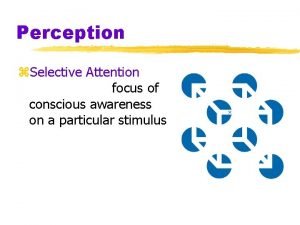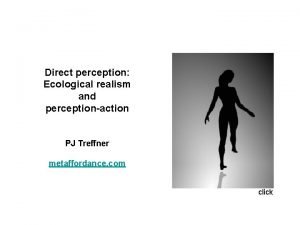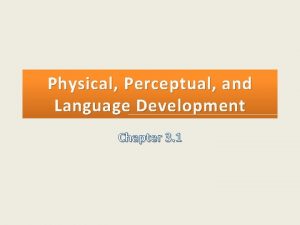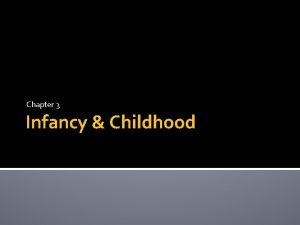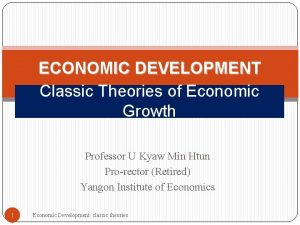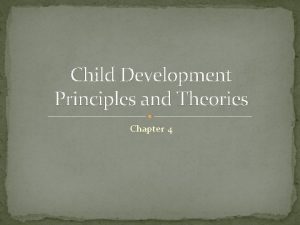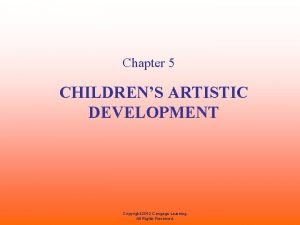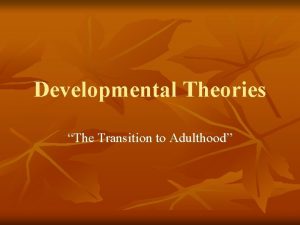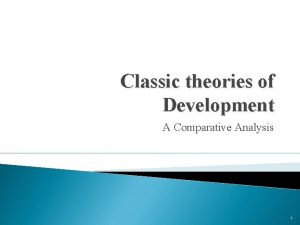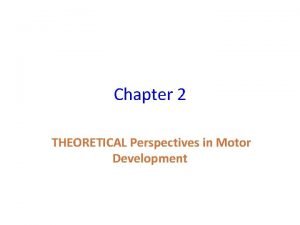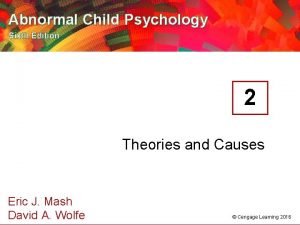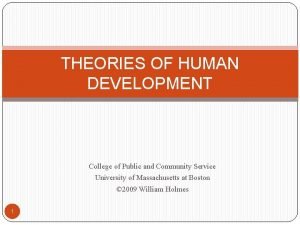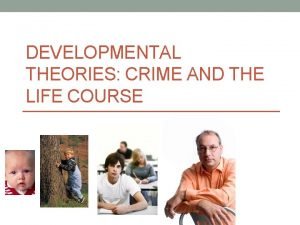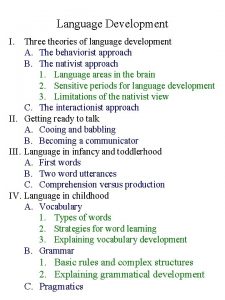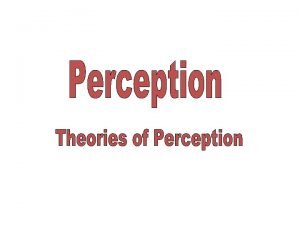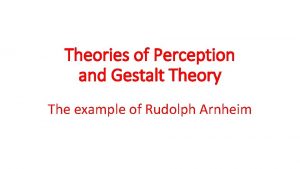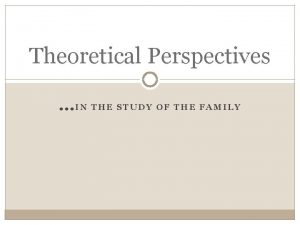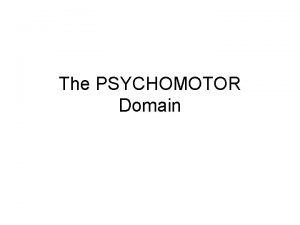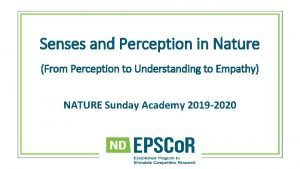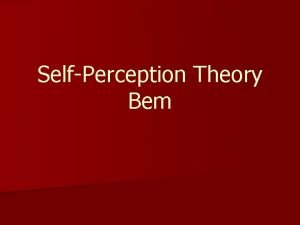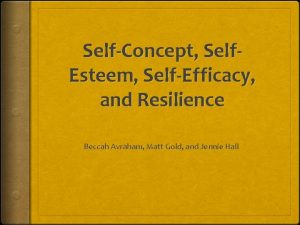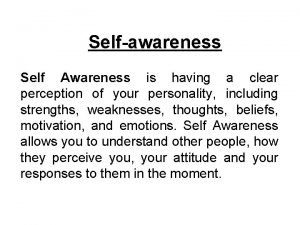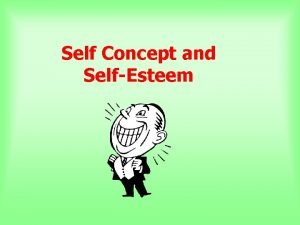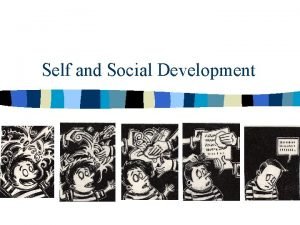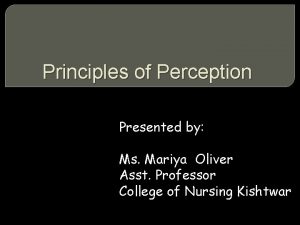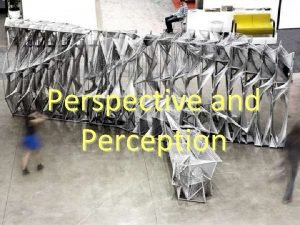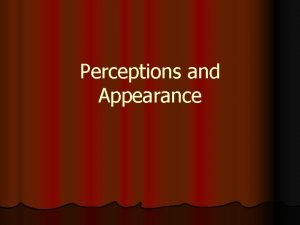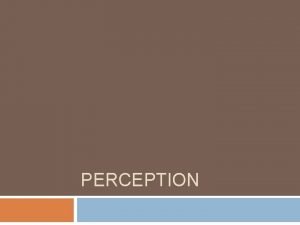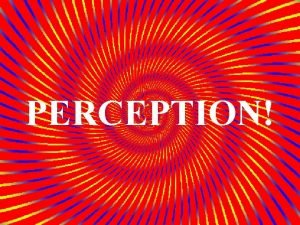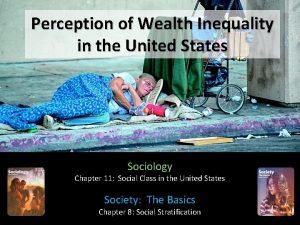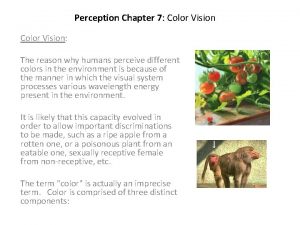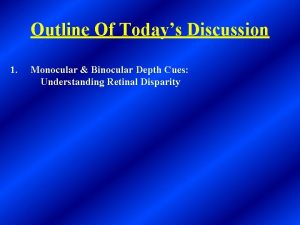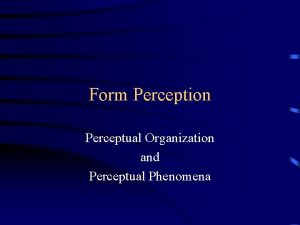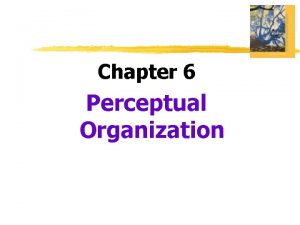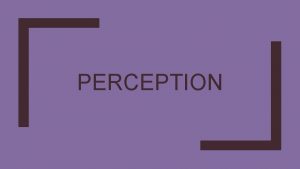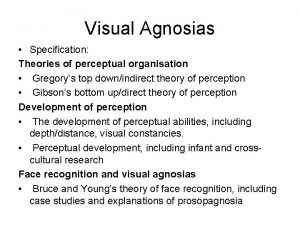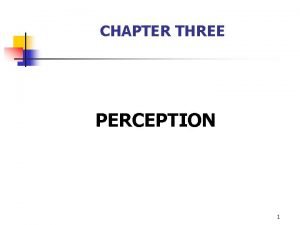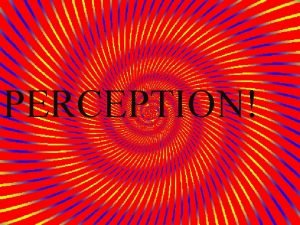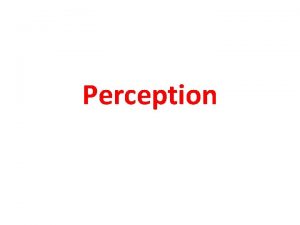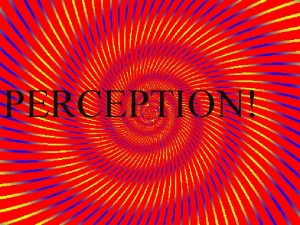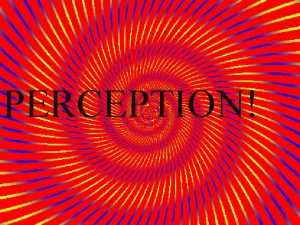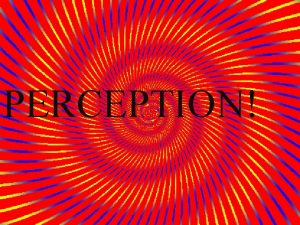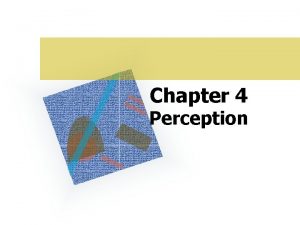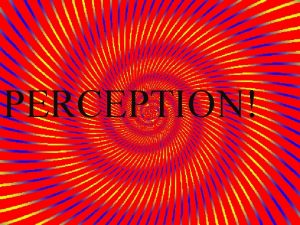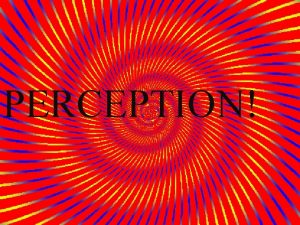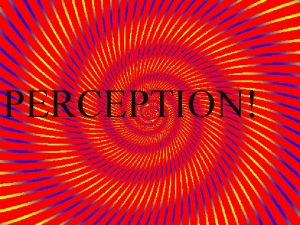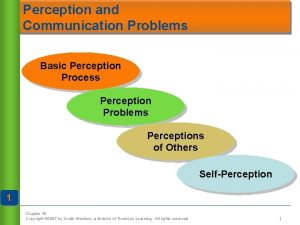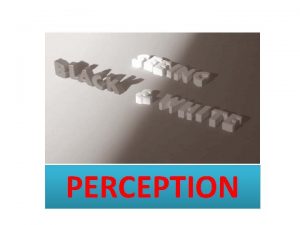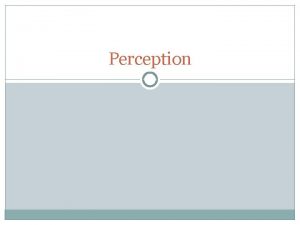Perception Theories of perceptual organisation Development of perceptual









































- Slides: 41

Perception Theories of perceptual organisation Development of perceptual abilities Face recognition

Theories of perceptual organisation Gibson’s direct theory Gregory’s indirect theory

Gibson’s direct theory • Optic array: Light structured by objects, surfaces and textures converges on the observer from every part of the surrounding environment. Information is unambiguous and invariant about how and where objects are in space

The importance of movement • Movement around our visual field enables us to collect visual information • Optic flow: - changes in light patters due to movement • Flow patterns: - objects in the visual environment flowing past a moving observer Nature of flow provides information to the observer about position and depth. Objects close to the observer move faster than objects farther away (motion parallax)

Invariants • Aspects of the environment that remain unchanging • Texture gradient: - change in relative size and compactness of objects in visual field (closer = coarser; farther = finer) • Horizon-ratio relation: - objects of the same height (whatever distance) are cut by the horizon in the same ratio

Affordances • Uses of objects are perceived directly as they afford certain responses to be made • The affordance of an object depends on: Circumstances it is encountered in Species • Perception occurs when there is an affordance plus environmental info to specify the affordance

Evaluation • Gibson & Walk’s visual cliff study found 6 -montholds refused to cross an apparent cliff. This suggests depth perception is innate, making it a direct/biological process. • Time-to-contact concept – the ability to judge what responses need to be made when approaching an object so collision is avoided. This is made using direct visual information, as shown by Lee et al. ’s long jumper study

IDA • Application – road markings, pilot training programmes and airport construction • Nature suggests perception is shaped by evolution and biology. But this is reductionist theory as it doesn’t explain individual differences when perceiving illusions, suggesting a higher cognitive process (e. g. Gregory’s theory) is involved. • It is also deterministic; a direct theory would mean universal perceptive abilities but there are crosscultural differences in perception.

Gregory’s indirect theory • Higher cognitive processes interpret direct sensory information available • Past experience and knowledge influence perception • Successful perception requires intelligence and reasoning in combining sensory information with knowledge based on previous experience

Hypothesis testing • Humans act like intuitive scientists, formulating and testing hypotheses against the world • Sensory data is incomplete so mental hypotheses help understand meaning • These can be wrong lead to the experience of visual illusions

Perceptual sets • Expectations form cognitive biases so the observer sees what they want to see • Makes perception faster but more likely to be wrong • Visual stimuli are a starting point for making informed guesses about their meaning • Context removes ambiguity and allows us to confirm a hypothesis

Evaluation • Simon & Levin – participants did not perceive a change in conversation partner mid-conversation because this was unexpected • Brochet – wine experts described red and white wines differently when they were the same wine coloured differently • Visual illusions – new hypotheses ought to be formed when aware of illusions yet they continue to be perceived

IDA • Application – US naval ship shot down commercial flight because of erroneous hypotheses • Methodological issues – studies don’t reflect real-world perception. If perception truly relied on hypothesis-testing, we would make more mistakes than we do

Development of perceptual abilities Infant studies Cross-cultural studies Depth/distance and visual constancies

Infant studies – depth/distance • Gibson & Walk - babies could perceive depth of the visual cliff • Bower et al. - infants shield their eyes from approaching objects , demonstrating motion parallax • Hofsten et al. - infants looked longer at a display matching the motion parallax effect after they'd been habituated to it • Yonas et al. – older infants use shadows as depth cues more than younger infants

Infant studies - visual constancies • Shape constancy Bower - infants preferred an image of a rectangle to a trapezoid which more closely represented what they were conditioned to look at • Size constancy Slater et al. - children observed a larger cube when it appeared to have the same retinal size as two other cubes

Evaluation • Perceptual completion & occlusion are perceptual abilities not present in infants Ghim found children cannot detect the Kanizsa square that requires integration of separate angular features Slater et al. found children couldn't distinguish between objects in occlusion until 2 months of age

Evaluation • Infants are especially susceptible to experimenter bias Lack of reaction may be explained by tiredness as opposed to habituation Infants have low visual acuity, so cannot see detailed pictures • Methodological issues greatly lower validity Small samples, lack of mundane realism

IDA • Nature/nurture are difficult to disentangle Abilities present after birth may be due to a maturing visual system (nature) Abilities present at birth may be due to sensory learning in the womb (nurture) Blakemore & Copper - innate visual mechanisms of kittens are shaped by experience (nature and nurture interaction)

IDA • Research into perceptual development tells us the critical period surgery must occur to fix squints before they become irreversible

Cross-cultural studies - depth/distance • Turnbull - Kenge was accustomed to dense forests and saw far away buffalo as small, so assumed they were insects. Kenge's lack of experience lead to an inability to use cues for distance to interpret size • Hudson - bantu children struggled to view a picture as 3 D before and after primary school whereas european children struggled only before primary school

Cross-cultural studies - visual constancies • Shape constancy Allport & Pettigrew - Zulus living in rural areas (with round windows) were unaffected by an illusion requiring knowledge of square windows • Size constancy Zulus are unaffected by the Müller-Lyer illusion because they live in round huts without cues for corners

Evaluation • More recent findings disputed these studies Page – altered wording of questions in Hudson’s study lead to Zulus appearing to perceive depth • Deregowski – different types of picture make it easier/harder to perceive depth: Epitomic illustrations provide no depth information Eidolic illustrations always appear 3 D

Evaluation • Interpretation of depth cues increases with age, so experience must play a role in perception Some depth cues are innate whereas others are forms of cultural expression Difficulty perceiving depth could be due to inexperience with culturally-relative depth cues in pictures

IDA • Methodological issues – imposed etic, small samples, communication barriers and low control • Non-human animal research is used to support research into perceptual development, creating problems with generalisability & ethics • Biology must have an effect on perception because retinal pigmentation varies between people and has been linked to difficulties perceiving the edges of objects

Face recognition Bruce & Young’s theory Case studies of prosopagnosia Explanations of prosopagnosia

Bruce & Young’s theory of face recognition

Evaluation • Young et al. – names were never recalled without some relevant personal information (person identity nodes come before name retrieval units) • Young et al. – faces were better match to politician’s identities than names (face recognition units come before name retrieval units)

Evaluation • Burton & Bruce – Interactive Activation and Competition (IAC) network suggests face recognition involves nodes with complex connections that better match the nervous system • Fantz – babies preferred faces to jumbled facial features (so they must have an independent face processor)

Evaluation • It would make sense to have an independent face processor because this has important social and adaptive functions • Gauthier et al. – the fusiform face area is active when distinguishing between types of bird and car, so it may be expertise that activates it rather than face recognition so this theory may be irrelevant

IDA • Application – facial cognitive biometric systems have been developed alongside face recognition research and have been used to identify criminals

Case studies into prosopagnosia • Cases that solely involve lack of face recognition are rare… PS damaged lateral occipital and temporal lobes in both hemispheres in a bus accident, and couldn’t recognise faces including her own. She scored on the normal range for object recognition

Case studies into prosopagnosia • Much more common are cases where individuals cannot recognise faces or objects… NS damaged both sides of his occipital lobe and temporal junction area and couldn’t recognise faces nor objects. However, his colour vision and visual acuity remained high

Case studies into prosopagnosia • In some cases, prosopagnosics have rudimentary face recognition… Mr W was a prosopagnosic farmer who couldn’t recognise people or himself but could recognise his cows and dogs. He could also match unfamiliar faces and individual facial features

Evaluation • Methodological issues Each study involves a unique pattern of brain damage so generalisations cannot be made Areas of the brain associated with prosopagnosia might be a relay mechanism rather than causing the agnosia Brain damaged patients may have general cognitive impairments, making them appear prosopagnosic Some prosopagnosics may have developed coping strategies, making them appear neurotypical

IDA • Ethical issues Confidentiality – prosopagnosia is so rare that using the initials of prosopagnosics in research still makes them identifiable Protection from harm – prosopagnosia is so rare that when prosopagnosics are found they are over-tested on so research disrupts their life and may cause psychological harm

Explanations of prosopagnosia • Duchaine et al. – family members shared face memory and similarity difficulties, suggesting a genetic explanation. An estimated 2% of the population suffer from hereditary prosopagnosia • PS’ f. MRI scans showed prosopagnosia may be due to damage to the fusiform face area and occipital face area in the right hemispheres

Explanations of prosopagnosia • Farah proposed a continuum: Object recognition difficulties Configural processes that decode structure; problems lead to alexia Holistic processes that compute relationships; problems lead to prosopagnosia

Evaluation • Garrido et al. – prosopagnosia showed weaker response in the FFA to faces than control • Prosopagnosics tend to have some object recognition difficulty but not vice versa. Therefore prosopagnosia could just be extreme object recognition difficulty (Humphreys & Riddoch)

Evaluation • Not all prosopagnosics have holistic processing difficulties. HJA showed holistic abilities, but wasn’t susceptible to the inversion effect, and PS’ local but not global processing was impaired, meaning she showed holistic processing • Different forms of prosopagnosia support Bruce & Young’s model Edward could describe a face but not remember information about it, showing problems with face recognition units CB could say whether a face was familiar but couldn’t remember names or information about them, showing problems with person identity nodes

IDA • Application – little can be done to treat prosopagnosia, but research increases awareness and provides reassurance to individuals suffering from it
 Perceptual set meaning
Perceptual set meaning Theories of perception
Theories of perception Direct perception
Direct perception Physical perceptual and language development
Physical perceptual and language development Internally programmed growth of a child
Internally programmed growth of a child Theories of growth and development
Theories of growth and development Dualistic development thesis
Dualistic development thesis Child development principles and theories
Child development principles and theories Kellogg's stages of artistic development
Kellogg's stages of artistic development Language
Language Levinson life stages
Levinson life stages Chenery's patterns of development
Chenery's patterns of development Motor learning theories
Motor learning theories Theories of normal and abnormal development
Theories of normal and abnormal development 5 theories of tourism development
5 theories of tourism development Theories of human development
Theories of human development Developmental theories of crime
Developmental theories of crime Three theories of language development
Three theories of language development Gregorys constructivist theory
Gregorys constructivist theory Gestalt theory of perception examples
Gestalt theory of perception examples Perception vs perspective
Perception vs perspective Perception in psychomotor domain
Perception in psychomotor domain Subjective time definition
Subjective time definition Nature of perception
Nature of perception Over justification effect
Over justification effect Self concept vs self esteem
Self concept vs self esteem It is having a clear perception of your personality
It is having a clear perception of your personality Self concept vs self esteem
Self concept vs self esteem Self image vs self perception
Self image vs self perception Chapter 5 sensation and perception
Chapter 5 sensation and perception Principle of context
Principle of context Perception vs perspective
Perception vs perspective Perception checks
Perception checks What does the word perception mean
What does the word perception mean What does the l mean
What does the l mean Selective perception
Selective perception Questions on perception
Questions on perception Perception of wealth
Perception of wealth What affects perception
What affects perception Chapter 7 vision and perception
Chapter 7 vision and perception Lembar jawaban papi kostick
Lembar jawaban papi kostick Binocular disparity depth perception
Binocular disparity depth perception
